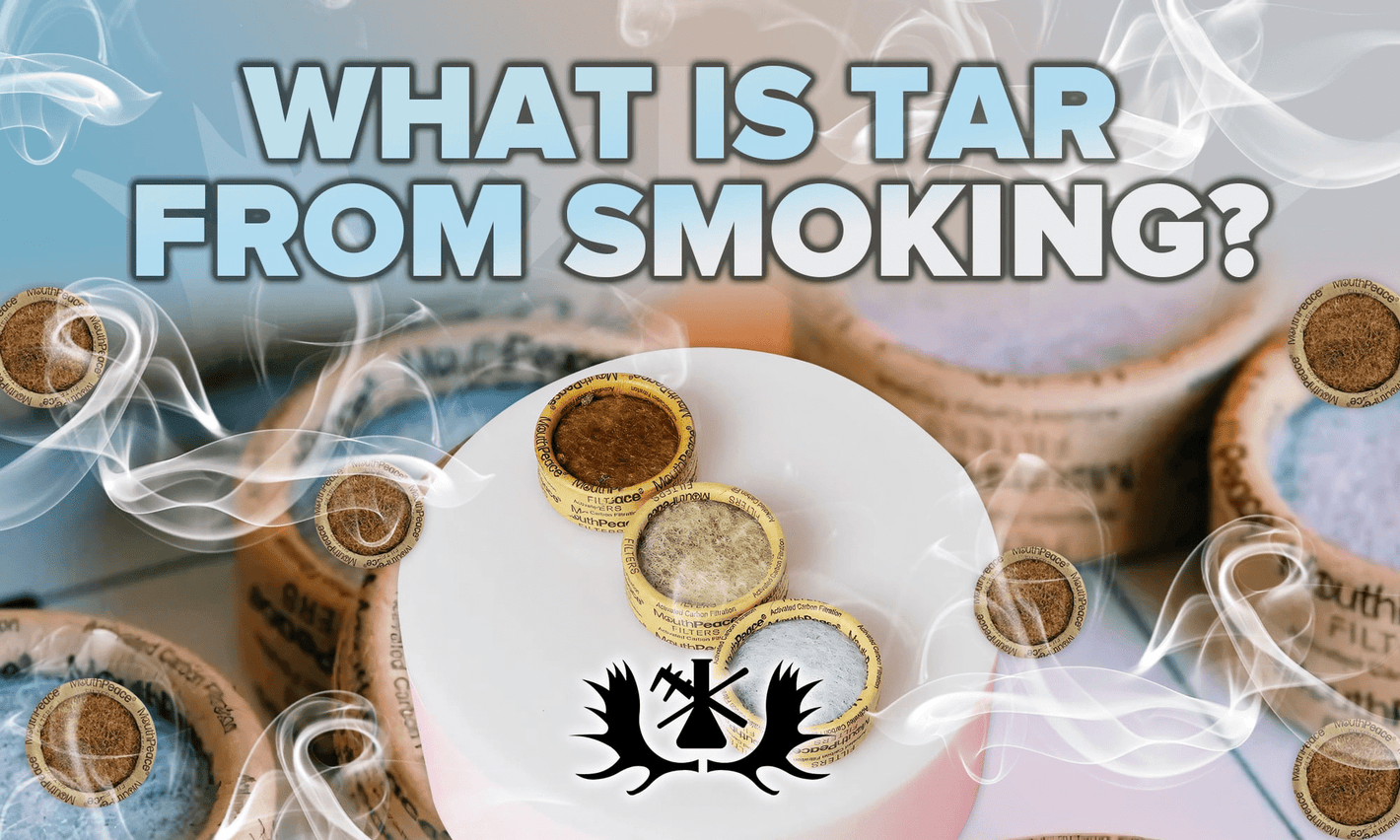What Is Tar From Smoking?

Ever wonder about that sticky gunk left behind in your pipe or lungs after smoking cigarettes or weed?
That brownish-black mess is called tar — and no, it’s not something added to your cannabis or tobacco. It’s a by-product of burning plant material, including tobacco products and marijuana.
Let’s break it down: what tar is, how it affects your body, and how you can protect yourself better with Moose Labs.
What Exactly Is Tar?
Tar forms when any tobacco, cannabis, or other plant matter burns. It’s not an additive — it’s created by the combustion process.
Tar is a sticky mix of particulate matter, aerosol residue, and toxic chemicals, including:
-
Carbon monoxide
-
Formaldehyde
-
Polycyclic aromatic hydrocarbons (PAHs)
-
Carcinogens (cancer-causing agents)
Bottom line: Tar is loaded with harmful chemicals you don’t want sitting in your lungs or clogging up your cilia — the tiny hairs that clean your respiratory tract.
How Tar Differs in Cigarette Smoke vs. Marijuana Smoke
Tar in Cigarette Smoke:
The FDA warns that cigarette smoke contains more than 7,000 toxic chemicals, with at least 70 known carcinogens that can cause diseases like COPD, emphysema, lung cancer, and heart disease.
Cigarette tar is the real villain behind these health problems — not just the nicotine.
Tar in Marijuana Smoke:
Cannabis might be natural, but burning marijuana still produces tar, aerosol residue, and toxicity risks. Big, deep inhales mean more tar gets stuck deeper in your lungs.
Is Marijuana Tar Safer Than Cigarette Tar?
Short answer: No.
There’s a common misconception that marijuana is safer because it’s “organic.” But once you light it, it’s a different story.
The American Lung Association and other public health sources have found that:
-
Smoking marijuana can expose you to just as much tar and carbon monoxide as smoking cigarettes.
-
Cannabis joints can deliver up to four times the amount of tar to your lungs compared to tobacco cigarettes.
-
Lack of filters, bigger hits, and longer holds mean more exposure to carcinogens and particulate matter.
Plus, marijuana smokers often take in a larger volume of smoke per puff compared to tobacco users, leading to greater risks of lung diseases like emphysema and chronic obstructive pulmonary disease.
However, there’s a solution:
Using a MouthPeace filter from Moose Labs reduces the tar and keeps more of those harmful chemicals out of your lungs. It traps gunk before it reaches your mouth, throat, and respiratory system.
How Tar Affects Your Health

Inhaling tar isn’t just gross — it causes real damage over time.
-
Respiratory Problems: Tar damages your cilia, blocks airways, and leads to a constant smoker’s cough, shortness of breath, and diseases like COPD and emphysema.
-
Lung Cancer Risk: Tar carries cancer-causing substances that damage DNA. According to the American Cancer Society and leading cancer centers, tar is one of the biggest drivers of lung cancer and heart disease.
-
Chronic Bronchitis: Even nonsmokers exposed to secondhand smoke face increased health risks from tar buildup.
Whether it’s tobacco smoke or marijuana, tar is the real threat — not just the nicotine or THC.
Best Ways to Reduce Tar When Smoking
You can’t fully escape tar, but you can lower your exposure in smart ways:
1. Bongs and Water Pipes:
Water can filter out some large particles but won’t catch the fine toxic chemicals and aerosol residue.
2. Vaping:
Vaping cannabis or tobacco reduces tar levels because it heats instead of burns. However, low-quality vapes can still release toxicity and harmful chemicals if the temperatures are too high.
3. MouthPeace Filters from Moose Labs (Best Way):

Moose Labs MouthPeace uses triple-layer activated carbon filters to catch particulate matter, resin, and carcinogens before they reach your lungs.
-
Works with pipes, joints, vapes, and bongs.
-
Made from biodegradable and recycled materials.
-
Available in fun styles, including glow-in-the-dark!
For smaller sessions, the MouthPeace Mini is perfect—it offers the same powerful filtration but is a more discreet size for joints and vapes.
Does Tar Leave Your Lungs After You Stop Smoking?

Good news: Yes, your lungs can heal!
When you stop smoking, your lungs start cleaning themselves:
-
12–24 hours: Carbon monoxide levels in your blood normalize.
-
1–2 weeks: Taste and smell sharpen.
-
2 weeks–3 months: Your heart attack risk drops; lung function improves.
-
1–9 months: Coughing and COPD symptoms start to improve.
-
1 year: Risk of heart disease cuts by 50%.
-
10 years: Risk of lung cancer drops by 50–70%.
According to the National Institutes of Health and gov health sources, the sooner you quit, the faster your body bounces back.
Final Thoughts
Whether you’re smoking cigarettes, weed, or anything in between, tar is a part of the deal. And it brings along toxic chemicals, carbon monoxide, and carcinogens that damage your lungs and overall public health.
But now you know the facts and have options to reduce the damage.
Moose Labs MouthPeace helps trap tar and nasty residues before they can settle in your lungs. This results in cleaner hits, better flavor, and less regret.
Want to enjoy your smoke while protecting your health? Check out our full line of MouthPeace filters and accessories.Your lungs—and your future self—will thank you.
FAQs
Can You Smoke Without Inhaling Tar?
Not completely, but MouthPeace filters significantly lower the amount of tar reaching your lungs.
Is Tar the Same as Nicotine?
No. Tar is the result of burning; nicotine is the addictive chemical found in tobacco.
Are Low-Tar Cigarettes Safer?
Nope. Low-tar labels are misleading. Most people smoke them harder and deeper, wiping out any so-called benefit.
Is Tobacco Cigarette Tar Harmful?
Yes — it’s the main driver behind lung diseases like COPD, emphysema, and lung cancer.
What Is Carbon Monoxide in Cigarettes?
It’s a toxic gas that forms during burning and steals oxygen from your bloodstream.
Do Hemp Vapes Produce Tar?
Less than smoking — but not zero. Always buy tested, safe devices to lower health risks.
Is Tar Worse in Blunts or Joints?
Blunts use tobacco wraps, so you’re getting tobacco tar and cannabis tar together — double trouble












